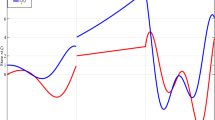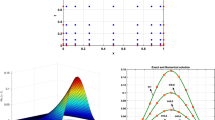Abstract
The main purpose of this work is to develop spectrally accurate and well conditioned pseudospectral schemes for solving fractional delay differential equations (FDDEs). The essential idea is to recast FDDEs into fractional integral equations (FIEs) and then discretize the FIEs via generalized fractional pseudospectral integration matrices (GFPIMs). We construct GFPIMs by employing the basis of weighted Lagrange interpolating functions, and provide an exact, efficient, and stable approach to computing GFPIMs. The GFPIM schemes have two remarkable features: (i) the endpoint singularity of the solution to FDDEs can be effectively captured via the tunable basis, and (ii) the linear system resulting from pseudospectral discretization is well conditioned. We also provide a rigorous convergence analysis for the particular FPIM schemes via a linear FIE with any \(\gamma >0\) where \(\gamma \) is the order of fractional integrals. Numerical results on benchmark FDDEs with smooth/singular solutions demonstrate the spectral rate of convergence for the GFPIM schemes. For FDDEs with piecewise smooth solutions, the GFPIM schemes can obtain accurate solutions but converge slowly due to their essential feature of “global” approximation on the entire time interval.



Similar content being viewed by others

References
Bhalekar, S., Daftardar-Gejji, V.: A predictor–corrector scheme for solving nonlinear delay differential equations of fractional order. J. Fract. Calc. Appl. 1(5), 1–9 (2011)
Moghaddam, B.P., Mostaghim, Z.S.: A numerical method based on finite difference for solving fractional delay differential equations. J. Taibah Univ. Sci. 7(3), 120–127 (2013)
Khader, M.M.: The use of generalized Laguerre polynomials in spectral methods for solving fractional delay differential equations. J. Comput. Nonlinear Dyn. 8(4), 041018 (2013)
Saeed, U., ur Rehman, M.: Hermite wavelet method for fractional delay differential equations. J. Differ. Equ. 2014, Article ID: 359093 (2014)
Zayernouri, M., Cao, W., Zhang, Z., Karniadakis, G.E.: Spectral and discontinuous spectral element methods for fractional delay equations. SIAM J. Sci. Comput. 36(6), B904–B929 (2014)
Sherif, M.N.: Numerical solution of system of fractional delay differential equations using polynomial spline functions. Appl. Math. 7(6), 518–526 (2016)
Muthukumar, P., Ganesh Priya, B.: Numerical solution of fractional delay differential equation by shifted Jacobi polynomials. Int. J. Comput. Math. 94(3), 471–492 (2017)
Zayernouri, M., Karniadakis, G.E.: Fractional Sturm–Liouville eigen-problems: theory and numerical approximation. J. Comput. Phys. 252, 495–517 (2013)
Ali, I., Brunner, H., Tang, T.: A spectral method for pantograph-type delay differential equations and its convergence analysis. J. Comput. Math. 27(2–3), 254–265 (2009)
Wang, Z.-Q., Wang, L.-L.: A Legendre–Gauss collocation method for nonlinear delay differential equations. Discrete Contin. Dyn. Syst. Ser. B 13(3), 685–708 (2010)
Wei, Y., Chen, Y.: Legendre spectral collocation methods for pantograph Volterra delay-integro-differential equations. J. Sci. Comput. 53(3), 672–688 (2012)
Zhang, R., Zhu, B., Xie, H.: Spectral methods for weakly singular Volterra integral equations with pantograph delays. Front. Math. China 8(2), 281–299 (2013)
Gu, Z., Chen, Y.: Legendre spectral-collocation method for Volterra integral equations with non-vanishing delay. Calcolo 51(1), 151–174 (2014)
Zhao, J., Cao, Y., Xu, Y.: Legendre spectral collocation methods for Volterra delay-integro-differential equations. J. Sci. Comput. 67(3), 1110–1133 (2016)
Wang, Z.-Q., Sheng, C.-T.: An \(hp\)-spectral collocation method for nonlinear Volterra integral equations with vanishing variable delays. Math. Comput. 85(298), 635–666 (2016)
Sheng, C.-T., Wang, Z.-Q., Guo, B.-Y.: An \(hp\)-spectral collocation method for nonlinear Volterra functional integro-differential equations with delays. Appl. Numer. Math. 105, 1–24 (2016)
Weideman, J.A.C., Reddy, S.C.: A MATLAB differentiation matrix suite. ACM Trans. Math. Softw. 26(4), 465–519 (2000)
Tang, X., Xu, H.: Fractional pseudospectral integration matrices for solving fractional differential, integral, and integro-differential equations. Commun. Nonlinear Sci. Numer. Simul. 30(1–3), 248–267 (2016)
Kilbas, A.A., Srivastava, H.M., Trujillo, J.J.: Theory and Applications of Fractional Differential Equations, 1st edn. Elsevier Science, Amsterdam (2006)
Elbarbary, E.M.E.: Pseudospectral integration matrix and boundary value problems. Int. J. Comput. Math. 84(12), 1851–1861 (2007)
Elgindy, K.T., Smith-Miles, K.A.: Solving boundary value problems, integral, and integro-differential equations using Gegenbauer integration matrices. J. Comput. Appl. Math. 237(1), 307–325 (2013)
Wang, L.-L., Samson, M.D., Zhao, X.: A well-conditioned collocation method using a pseudospectral integration matrix. SIAM J. Sci. Comput. 36(3), A907–A929 (2014)
Du, K.: On well-conditioned spectral collocation and spectral methods by the integral reformulation. SIAM J. Sci. Comput. 38(5), A3247–A3263 (2016)
Chen, S., Shen, J., Wang, L.-L.: Generalized Jacobi functions and their applications to fractional differential equations. Math. Comput. 85(300), 1603–1638 (2016)
Tang, X., Liu, Z., Wang, X.: Integral fractional pseudospectral methods for solving fractional optimal control problems. Automatica 62, 304–311 (2015)
Canuto, C., Hussaini, M.Y., Quarteroni, A., Zang, T.A.: Spectral Methods: Fundamentals in Single Domains, 1st edn. Springer, Berlin (2006)
Chen, Y., Tang, T.: Convergence analysis of the Jacobi spectral-collocation methods for Volterra integral equations with a weakly singular kernel. Math. Comput. 79(269), 147–167 (2010)
Ragozin, D.L.: Polynomial approximation on compact manifolds and homogeneous spaces. Trans. Am. Math. Soc. 150, 41–53 (1970)
Ragozin, D.L.: Constructive polynomial approximation on spheres and projective spaces. Trans. Am. Math. Soc. 162, 157–170 (1971)
Chen, Y., Li, X., Tang, T.: A note on Jacobi spectral-collocation methods for weakly singular Volterra integral equations with smooth solutions. J. Comput. Math. 31(1), 47–56 (2013)
Mastroianni, G., Occorsio, D.: Optimal systems of nodes for Lagrange interpolation on bounded intervals. A survey. J. Comput. Appl. Math. 134(1–2), 325–341 (2001)
Morgado, M.L., Ford, N.J., Lima, P.M.: Analysis and numerical methods for fractional differential equations with delay. J. Comput. Appl. Math. 252, 159–168 (2013)
Shen, J., Tang, T., Wang, L.-L.: Spectral Methods: Algorithms, Analysis and Applications, 1st edn. Springer, Berlin (2011)
Kufner, A., Persson, L.E.: Weighted Inequalities of Hardy Type, 1st edn. World Scientific, New York (2003)
Acknowledgements
The authors would like to express their gratitude to the associate editor and the anonymous reviewers for their constructive comments, which shaped the paper into its final form. The work of the first author was partially supported by the Fundamental Research Funds for the Central Universities (Grant No. 3102016ZY003). The work of the second author was partially supported by the Natural Sciences and Engineering Research Council of Canada (NSERC, RGPIN-2016-05386), and the National Natural Science Foundation of China (Grant No. 61473116). The work of the third author was partially supported by the National Natural Science Foundation of China (Grant No. 11472223), the Natural Science Foundation of Shaanxi Province (Grant No. 2016JM1015), and the Science and Technology Program of Shenzhen Government (Grant No. JCYJ20160331142601031).
Author information
Authors and Affiliations
Corresponding author
Appendices
Appendix A: Proof of Theorem 1
Proof
In order to calculate the integral in Eq. (11), we first employ the change of variables
to transform the integral interval \([t_L,\psi (t_k)]\) to the standard interval \([-1,+1]\). Then, we have
Substituting Eqs. (A.1) and (A.2) into Eq. (11) and taking account of Eqs. (1) and (12) yields
Recalling that \({\mathcal {L}}_{i}(\sigma ;t_{L},\psi (t_{k}))\in {\mathcal {P}}_{N-1}\), the integral in the last equality of Eq. (A.3) can then be calculated exactly using the JG quadrature [33, p. 80]. Thus, Eq. (15a) follows. In the same way, Eq. (15b) can be obtained. \(\square \)
Appendix B: Proof of Theorem 5
Proof
Using Eqs. (45) and (43c), we have
Now, it follows from Lemma 2 that
Next, we estimate \(\Vert {\mathcal {E}}_{2}(\tau )\Vert _{\infty }\). It is clear from Eq. (40a) that \(e(\tau )\in C[-1,+1]\) as \(g(\tau )\) is assumed to be sufficiently smooth. Consequently, using Lemma 3 and Theorem 4, we have
Thus, combining Eqs. (B.1)–(B.3) and taking account of N sufficiently large leads to Eq. (46). \(\square \)
Appendix C: Proof of Theorem 6
Proof
It follows from Eq. (45) and the generalized Hardy inequality (see, e.g., [34]) that
Now, using Lemma 2, we have
Next, it follows from Eq. (B.3) that
Thus, combining Eqs. (C.1)–(C.3) and recalling the estimate of \(\Vert e(\tau )\Vert _{\infty }\) in Eq. (46) leads to Eq. (47) provided that N is sufficient large. \(\square \)
Rights and permissions
About this article
Cite this article
Tang, X., Shi, Y. & Xu, H. Well Conditioned Pseudospectral Schemes with Tunable Basis for Fractional Delay Differential Equations. J Sci Comput 74, 920–936 (2018). https://doi.org/10.1007/s10915-017-0473-0
Received:
Revised:
Accepted:
Published:
Issue Date:
DOI: https://doi.org/10.1007/s10915-017-0473-0
Keywords
- Delay differential equations
- Pseudospectral integration matrices
- Convergence analysis
- Fractional derivatives



